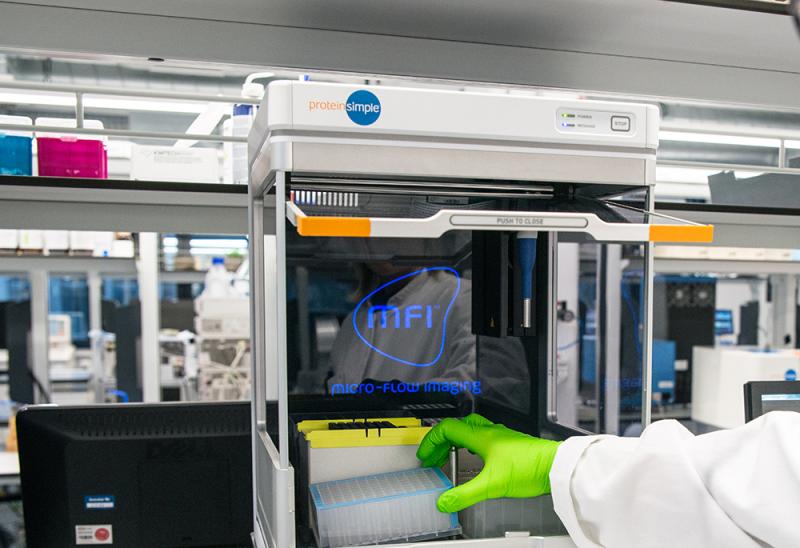Micro-Flow Imaging (MFI)
Sizing, Quantifying, Visualizing and Identifying (Sub-)Visible Particles.

Micro-Flow Imaging (MFI) - officially called flow imaging microscopy (FIM) or dynamic imaging analysis (DIA) - is a well-established and frequently-used technique for sizing, quantifying, visualizing and, in certain cases, identifying (sub-) visible particles. In MFI , bright-field images are captured in successive frames as a continuous sample stream passes through a flow-cell positioned in the field of view of a microscopic system. The digital images of the particles present in the sample are processed by image morphology analysis software that allows their quantification in size and count.
Coriolis operates several systems from different suppliers, such as Micro-Flow Imaging devices from ProteinSimple and FlowCam systems from Fluid Imaging Technology. These instruments typically cover a size range from about 1 to 400 µm, while the upper particle concentration limit is typically higher than that of light obscuration systems. Besides enumerating the subvisible particles present in the sample, flow imaging microscopy provides information about particle morphology for particles larger than about 3-4 µm. This capability marks an inherent advantage of MFI over many other particle characterization techniques, as it may allow identification of substances commonly present in biopharmaceuticals, such as silicone oil droplets.
Quality & Biosafety Level
We provide all our analytical services with the highest quality standards. Each project is carried out by experienced scientists and every report or data presentation is comprehensively checked by a scientific reviewer. We offer this technology with the following quality and biosafety level:
MFI has become an established technique for subvisible particle analysis, though no monograph/specifications in the pharmacopoeias exist so far. The instructional chapter USP<1787> mentions MFI as a possible orthogonal technique for subvisible particle analysis in addition to light obscuration. Even though MFI is also a light-based technique, it is typically superior to light obscuration in the detection of particles with a refractive index close to that of the surrounding formulation.
MFI is primarily used as a research tool, but has gained in importance, for example, during trouble shooting to further characterize or identify subvisible particles detected by light obscuration. The identification of silicone oil-like droplets in prefilled syringes or double-chamber cartridges is a major application of the technique. At Coriolis, MFI can be offered in full GMP compliance for, e.g., lot release testing.
Standardized Methods or Dedicated Method Development
For common sample types, we can often apply standardized methods with little setup effort. On top of this, our experienced analytical scientists perform in-depth method development or method optimization tailored to your drug substance, product type and development phase. Under GMP, we also offer full method validation or compendial method verification.
Method development
During method development, we tailor sample preparation, method settings, and data analysis to the needs of your project and sample.
For this purpose, we include a representative sample and, where available, suitable reference standards and stressed/degraded materials. This way, our analytical scientists can design a method that is highly suitable for your needs, stability indicating, as well as robust and repeatable. Upon request, we compile a detailed method description for your records.
This can be applied under R&D and GMP. Read more
Method qualification
A method qualification is the initial assessment of the performance of an analytical procedure to show that it is suitable for the intended purpose.
During method qualification, our analytical scientists perform a documented testing that demonstrates that the analytical procedure meets certain acceptance criteria in several categories. These may include repeatability, linearity, intermediate precision, robustness and more. We compile a qualification plan and a qualification report including all relevant data.
This can be applied under R&D and GMP. Read more
Method validation
A method validation is the confirmation under highly controlled conditions that the performance of an analytical procedure is suitable for the intended purpose.
During method validation, our analytical scientists perform a documented testing, which demonstrates that the analytical procedure consistently produces a result that meets the pre-determined acceptance criteria. We compile a validation plan and a validation report including all relevant data.
This can be applied under GMP. Read more
Contact us
Contact us
Do you have any questions? Please contact Dr. Jörg Müller!
Phone: +49 89 41 77 60 – 111
Mail: joerg.mueller@coriolis-pharma.com


